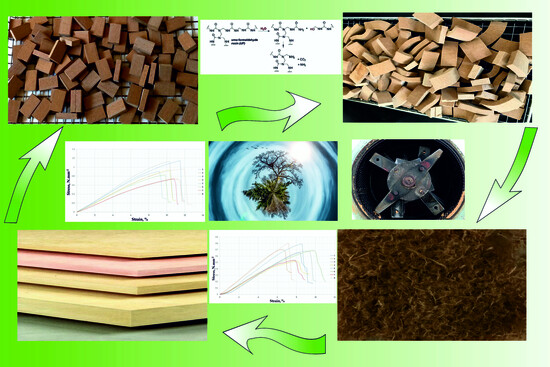The Impact of Hydrolysis Regime on the Physical and Mechanical Characteristics of Medium-Density Fiberboards Manufactured from Recycled Wood Fibers
Abstract
:1. Introduction
2. Materials and Methods
3. Results and Discussion
4. Conclusions
Author Contributions
Funding
Institutional Review Board Statement
Informed Consent Statement
Data Availability Statement
Acknowledgments
Conflicts of Interest
References
- Medium-Density Fiberboard (MDF) Market Size & Share Analysis—Growth Trends & Forecasts (2023–2028). Available online: https://www.mordorintelligence.com/industry-reports/medium-density-fiberboard-mdf-market (accessed on 15 September 2023).
- Neykov, N.; Antov, P.; Savov, V. Circular Economy Opportunities for Economic Efficiency Implement in Wood-Based Panel Industry. In Proceedings of the 11th International Scientific Conference “Business and Management 2020”, Vilnius, Lithuania, 7–8 May 2020; pp. 8–17, ISBN 978-609-476-231-4. [Google Scholar] [CrossRef]
- Garcia, C.A.; Hora, G. State-of-the-art of waste wood supply chain in Germany and selected European countries. Waste Manag. 2017, 70, 189–197. [Google Scholar] [CrossRef] [PubMed]
- Besserer, A.; Troilo, S.; Girods, P.; Rogaume, Y.; Brosse, N. Cascading Recycling of Wood Waste: A Review. Polymers 2021, 13, 1752. [Google Scholar] [CrossRef] [PubMed]
- Kim, M.H.; Song, H.B. Analysis of the Global Warming Potential for Wood Waste Recycling Systems. J. Clean. Prod. 2014, 69, 199–207. [Google Scholar] [CrossRef]
- Hellström, L.M.; Carlberg, T.; Engstrand, P.; Gradin, P.A.; Gregersen, Ø.W. Evaluation of collimated chipping technology for reducing en- ergy consumption in mechanical pulping. J. Sci. Technol. Forest Prod. Process. 2012, 2, 6–9. [Google Scholar]
- Lykidis, C.; Grigoriou, A. Hydrothermal recycling of waste and performance of the recycled wooden particleboards. Waste Manag. 2008, 28, 57–63. [Google Scholar] [CrossRef] [PubMed]
- Iždinský, J.; Vidholdová, Z.; Reinprecht, L. Particleboards from Recycled Wood. Forests 2020, 11, 1166. [Google Scholar] [CrossRef]
- Zhang, Y.; He, Z.B.; Xue, L.; Chu, D.M.; Mu, J. Influence of a Urea–Formaldehyde Resin Adhesive on Pyrolysis Characteristics and Volatiles Emission of Poplar Particleboard. RSC Adv. 2016, 6, 12850–12861. [Google Scholar] [CrossRef]
- Savov, V.; Antov, P.; Panchev, C.; Lubis, M.A.R.; Lee, S.H.; Taghiyari, H.R.; Todorova, M.; Petrin, S. Effect of Hydrolysis Regime on the Properties of Fibers Obtained from Recycling Medium-Density Fiberboards. Fibers 2023, 11, 64. [Google Scholar] [CrossRef]
- Wan, H.; Wang, X.-M.; Barry, A.; Shen, J. Recycling wood composite panels: Characterizing recycled materials. Bioresources 2014, 9, 7554–7565. [Google Scholar] [CrossRef]
- Michanicki, A. Recovery of fibers and particles from wood-based products. In Proceedings of the Forest Products Society Conference on Use of Recycled Wood and Paper in Building Applications, Madison, WI, USA, 9–11 September 1997. [Google Scholar]
- Kharazipour, A.; Kües, U. Recycling of wood composites and solid wood products. In Wood Production, Wood Technology, and Biotechnological Impacts; Universitätsverlag Göttingen: Göttingen, Germany, 2007; pp. 509–533. [Google Scholar]
- Mitchell, A.; Stevens, G. A Life Cycle Assessment of Closed Loop MDF Recycling Using the Microrelease Process to Produce Recycled Wood Fiber from MDF Waste; Final Report of WRAP Project MDD005; The Old Academy: Banbury, UK, 2009; ISBN 1-84405-417-9. [Google Scholar]
- Zimmer, A.; Bachmann, S.A.L. Challenges for recycling medium-density fiberboard (MDF). Results Eng. 2023, 19, 101277. [Google Scholar] [CrossRef]
- Hwang, C.Y.; Hse, C.Y.; Shupe, T.F. Effects of recycled fiber on the properties of fiberboard panels. Forest Prod. J. 2005, 55, 61–64. [Google Scholar]
- Panchev, C.; Savov, V. Recycling of Medium Density Fibreboards—A Review. Innov. Woodwork. Ind. Eng. Des. 2022, 1, 39–46. [Google Scholar]
- Antov, P.; Savov, V. Possibilities for Manufacturing Eco-friendly Medium Density Fiberboards from Recycled Fibers—A Review. In Proceedings of the 30th International Conference on Wood Science and Technology—ICWST 2019 “IMPLEMENTATION OF WOOD SCIENCE IN WOODWORKING SECTOR” & 70th Anniversary of Drvna industrija Journal, Zagreb, Croatia, 12–13 December 2019; pp. 18–24. [Google Scholar]
- Irle, M.; Privat, F.; Couret, L.; Belloncle, C.; Déroubaix, G.; Bonnin, E.; Cathala, B. Advanced recycling of post-consumer solid wood and MDF. Wood Mat. Sci. Eng. 2018, 11, 19–23. [Google Scholar] [CrossRef]
- Roffael, E.; Athanassiadou, E.; Mantanis, G. Recycling of particle and fiberboards using the extruder technique. In Proceedings of the Umweltschutz in der Holzwerkstoffindustrie; Georg-August Universitat Gottingen: Goettingen, Germany, 2002; pp. 56–65. [Google Scholar]
- Mantanis, G.I.; Athanassiadou, E.; Nakos, P.; Coutinho, A. A New Process for Recycling Waste Fiberboards. In Proceedings of the 38th International Wood Composites Symposium, Pullman, WA, USA, 5–8 April 2004; pp. 119–122. [Google Scholar]
- Franke, R.; Roffael, E. Zum recycling von span-und MDFplatten. Holz Roh-Werkstoff 1998, 56, 79–82. [Google Scholar] [CrossRef]
- Nuryawan, A.; Risnasari, I.; Pohan, A.P.; Husna, A.U.; Nasution, T.I.; Banurea, R.; Hartini, K.S. Properties of fiberboard (F.B.s) and recycle fiberboard (rFBs) and analysis of their wastage after recycling. IOP Conf. Ser. Mater. Sci. Eng. 2020, 935, 012060. [Google Scholar] [CrossRef]
- Irle, M.; Barbu, M.C. Wood-based panels technology. In Wood-Based Panels: An Introduction for Specialists; Thoemen, H., Irle, M., Šernek, M., Eds.; Brunel University Press: London, UK, 2010; Available online: http://www.cost.eu/media/publications/10-35-Wood-Based-Panels-An-Introductionfor-Specialists (accessed on 15 September 2023).
- Pizzi, A.; Papadopoulos, A.N.; Policardi, F. Wood composites and their polymer binders. Polymers 2020, 12, 1115. [Google Scholar] [CrossRef] [PubMed]
- Mantanis, G.I.; Athanassiadou, E.T.; Barbu, M.C.; Wijnendaele, K. Adhesive systems used in the European particleboard, MDF and OSB industries. Wood Mater. Sci. Eng. 2018, 13, 104–116. [Google Scholar] [CrossRef]
- Roffael, E.; Behn, C.; Schneider, T.; Krug, D. Bonding of recycled fibers with urea-formaldehyde resins. Int. Wood Prod. J. 2016, 7, 36–45. [Google Scholar] [CrossRef]
- Kristak, L.; Antov, P.; Bekhta, P.; Lubis, M.A.R.; Iswanto, A.H.; Reh, R.; Sedliacik, J.; Savov, V.; Taghiayri, H.; Papadopoulos, A.N.; et al. Recent Progress in Ultra-Low Formaldehyde Emitting Adhesive Systems and Formaldehyde Scavengers in Wood-Based Panels: A Review. Wood Mater. Sci. Eng. 2023, 18, 763–782. [Google Scholar] [CrossRef]
- Dunky, M. Urea–formaldehyde (UF) adhesive resins for wood. Int. J. Adhes. Adhes. 1998, 18, 95–107. [Google Scholar] [CrossRef]
- Chuang, I.; Maciel, E. NMR Study of the Stabilities of Urea-Formaldehyde Resin Components Toward Hydrolytic Treatments. J. App. Pol. Sci. 1994, 52, 1637–1651. [Google Scholar] [CrossRef]
- Abdullah, Z.A.; Park, B.D. Hydrolytic Stability of Cured UF Resins Modified by Additives. J. App. Pol. Sci. 2009, 114, 1011–1017. [Google Scholar] [CrossRef]
- Girods, P.; Dufour, A.; Rogaume, Y.; Rogaume, C.; Zoulalian, A. Pyrolysis of Wood Waste Containing Urea-Formaldehyde and Melamine-Formaldehyde Resins. J. Anal. Appl. Pyrolysis 2008, 81, 113–120. [Google Scholar] [CrossRef]
- Grigsby, W.J.; Carpenter, J.E.P.; Sargent, R. Investigating the extent of urea formaldehyde resin cure in medium density fiberboard: Resin extractability and fiber effects. J. Wood Chem. Technol. 2014, 34, 225–238. [Google Scholar] [CrossRef]
- Grigsby, W.J.; Thumm, A.; Carpenter, J.E.P.; Hati, N. Investigating the extent of urea formaldehyde resin cure in medium density fiberboard: Characterization of extractable resin components. Int. J. Adhes. Adhes. 2014, 50, 50–56. [Google Scholar] [CrossRef]
- Lubis, M.A.R.; Park, B.D. Analysis of the hydrolysates from cured and uncured urea-formaldehyde (UF) resins with two F/U mole ratios. Holzforschung 2018, 72, 759–768. [Google Scholar] [CrossRef]
- Lubis, M.A.R.; Hong, M.K.; Park, B.D.; Lee, S.M. Effects of recycled fiber content on the properties of medium density fiberboard. Eur. J. Wood Wood Prod. 2018, 76, 1515–1526. [Google Scholar] [CrossRef]
- Liu, M.; Wang, Y.; Wu, Y.; Wan, H. Hydrolysis and recycling of urea formaldehyde resin residues. J. Hazard. Mater. 2018, 355, 96–103. [Google Scholar] [CrossRef]
- Bütün, F.Y.; Sauerbier, P.; Militz, H.; Mai, C. The effect of fiberboard (MDF) disintegration technique on wood polymer composites (WPC) produced with recovered wood particles. Compos. Part A Appl. Sci. Manuf. 2019, 118, 312–316. [Google Scholar] [CrossRef]
- Bütün, F.Y.; Mayer, A.K.; Ostendorf, K.; Gröne, O.-E.Z.; Krause, K.C.; Schöpper, C.; Mertens, O.; Krause, A.; Mai, C. Recovering fibers from fiberboards for wood polymer composites production. Int. Wood Prod. J. 2018, 9, 42–49. [Google Scholar] [CrossRef]
- Lubis, M.A.R.; Hong, M.K.; Park, B.D. Hydrolytic Removal of Cured Urea–Formaldehyde Resins in Medium-Density Fiberboard for Recycling. J. Wood Chem. Technol. 2018, 38, 1–14. [Google Scholar] [CrossRef]
- Hagel, S.; Joy, J.; Cicala, G.; Saake, B. Recycling of Waste MDF by Steam Refining: Evaluation of Fiber and Paper Strength Properties. Waste Biomass Valorization 2021, 2, 5701–5713. [Google Scholar] [CrossRef]
- Hagel, S.; Saake, B. Fractionation of Waste MDF by Steam Refining. Molecules 2020, 25, 2165. [Google Scholar] [CrossRef] [PubMed]
- Ormondroyd, G.A.; Elias, R.M.; Curling, S.F. MDF Recovery: Recycled MDF technologies for routed and laminated applications. In Proceedings of the Conference: COST action FP1303, Sofia, Bulgaria, 28 February–1 March 2017. [Google Scholar]
- Moezzipour, B.; Ahmadi, M.; Abdolkhani, A.; Doosthoseini, K. Chemical changes of wood fibers after hydrothermal recycling of MDF waste. J. Ind. Acad. Wood Sci. 2017, 14, 133–138. [Google Scholar] [CrossRef]
- Moezzipour, B.; Abdolkhani, A.; Doost-hoseini, K.; Ramazani, S.A.A.; Tarmian, A.S. Practical properties and formaldehyde emission of medium density fiberboards (MDFs) recycled by electrical method. Eur. J. Wood Wood Prod. 2018, 76, 1287–1294. [Google Scholar] [CrossRef]
- Ahmadi, M.; Moezzipour, B. Thermal Stability of Wood Fibers Produced from Recycled Medium Density Fiberboards. Drvna Ind. 2019, 70, 149–155. [Google Scholar] [CrossRef]
- Cowling, E.B.; Merrill, W. Nitrogen in wood and its role in wood deterioration. Can. J. Bot. 2011, 44, 1539–1554. [Google Scholar] [CrossRef]
- Dazmiri, M.K.; Kiamahalleh, M.V.; Kiamahalleh, M.V.; Mansouri, H.R.; Moazami, V. Revealing the Impacts of Recycled Urea–Formaldehyde Wastes on the Physical–Mechanical Properties of MDF. Eur. J. Wood Wood Prod. 2018, 77, 293–299. [Google Scholar] [CrossRef]
- Bütün Buschalsky, F.Y.; Mai, C. Repeated thermo-hydrolytic disintegration of medium density fiberboards (MDF) for the production of new MDF. Eur. J. Wood Prod. 2021, 79, 1451–1459. [Google Scholar] [CrossRef]
- Carvalho, L.; Costa, C. A global model for the hot-pressing of MDF. J. Wood Sci Technol. 2003, 37, 241–258. [Google Scholar] [CrossRef]
- Gul, W.; Khan, A.; Shakoor, A. Impact of Hot Pressing Temperature on Medium Density Fiberboard (MDF). Perform. Adv. Mater. Sci. Eng. 2017, 2017, 4056360. [Google Scholar] [CrossRef]
- Savov, V. Engineering of Selected Properties of Light Medium Density Fibreboards Produced from Hardwood Tree Species. Innov. Woodwork. Ind. Eng. Des. 2020, 1, 53–59. [Google Scholar]
- EN 310:1999; Wood-Based Panels—Determination of Modulus of Elasticity in Bending and of Bending Strength. European Committee for Standardization (CEN): Brussels, Belgium, 1999.
- EN 317:1998; Particleboards and Fibreboards—Determination of Swelling in Thickness after Immersion in Water. European Committee for Standardization (CEN): Brussels, Belgium, 1998.
- EN 319:1993; Particleboards and Fibreboards; Determination of Tensile Strength Perpendicular to the Plane of the Board. European Committee for Standardization (CEN): Brussels, Belgium, 2001.
- EN 323:2001; Wood-Based Panels—Determination of Density. European Committee for Standardization (CEN): Brussels, Belgium, 2001.
- EN ISO 12460-5:2015; Wood-Based Panels-Determination of Formaldehyde Release—Part 5. Extraction Method (Called the Perforator Method). European Committee for Standardization: Brussels, Belgium, 2015.
- EN 622-5:2010; Fibreboards—Specifications—Part 5: Requirements for Dry Process Boards (MDF). European Committee for Standardization (CEN): Brussels, Belgium, 2010.
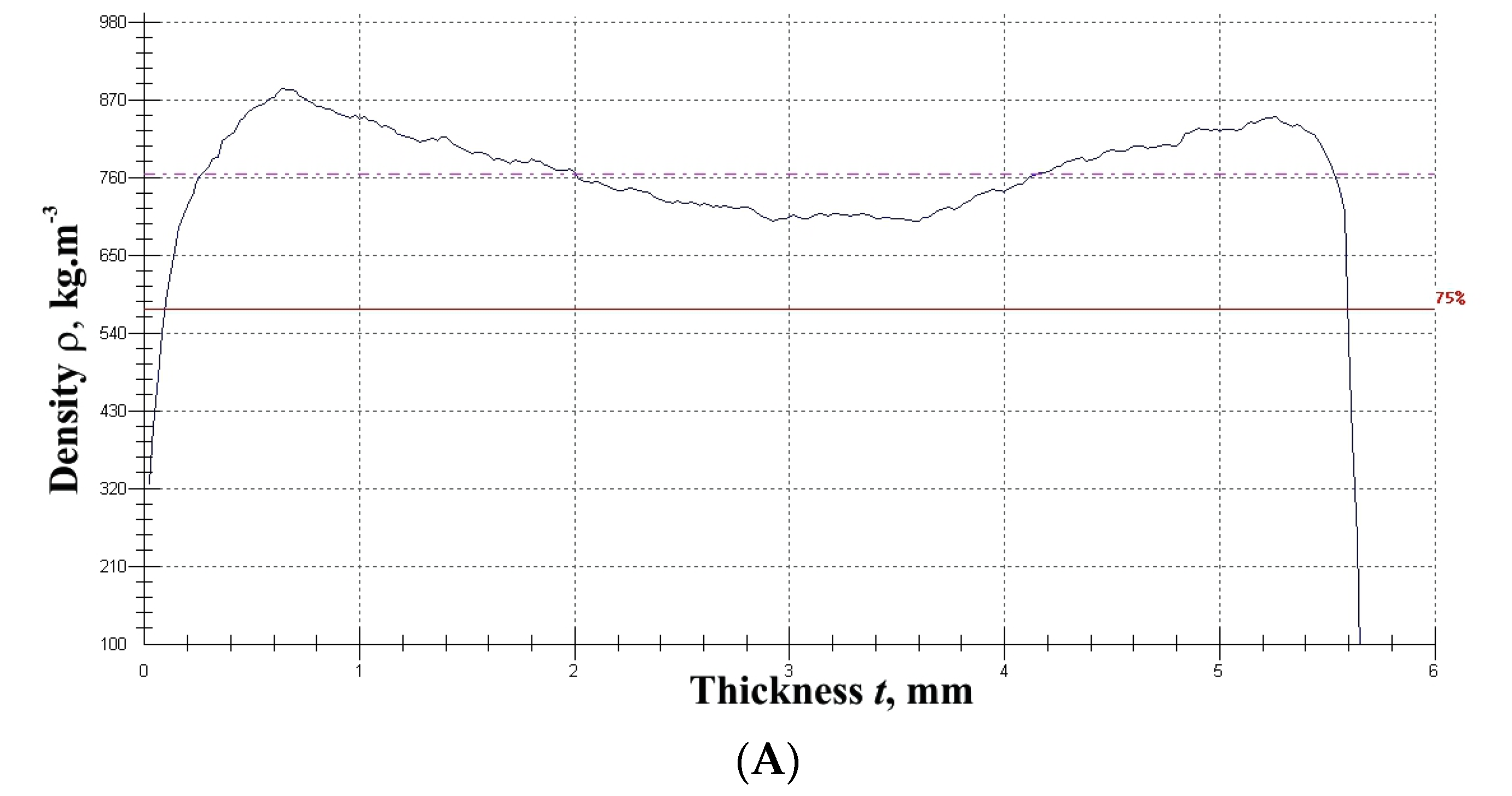
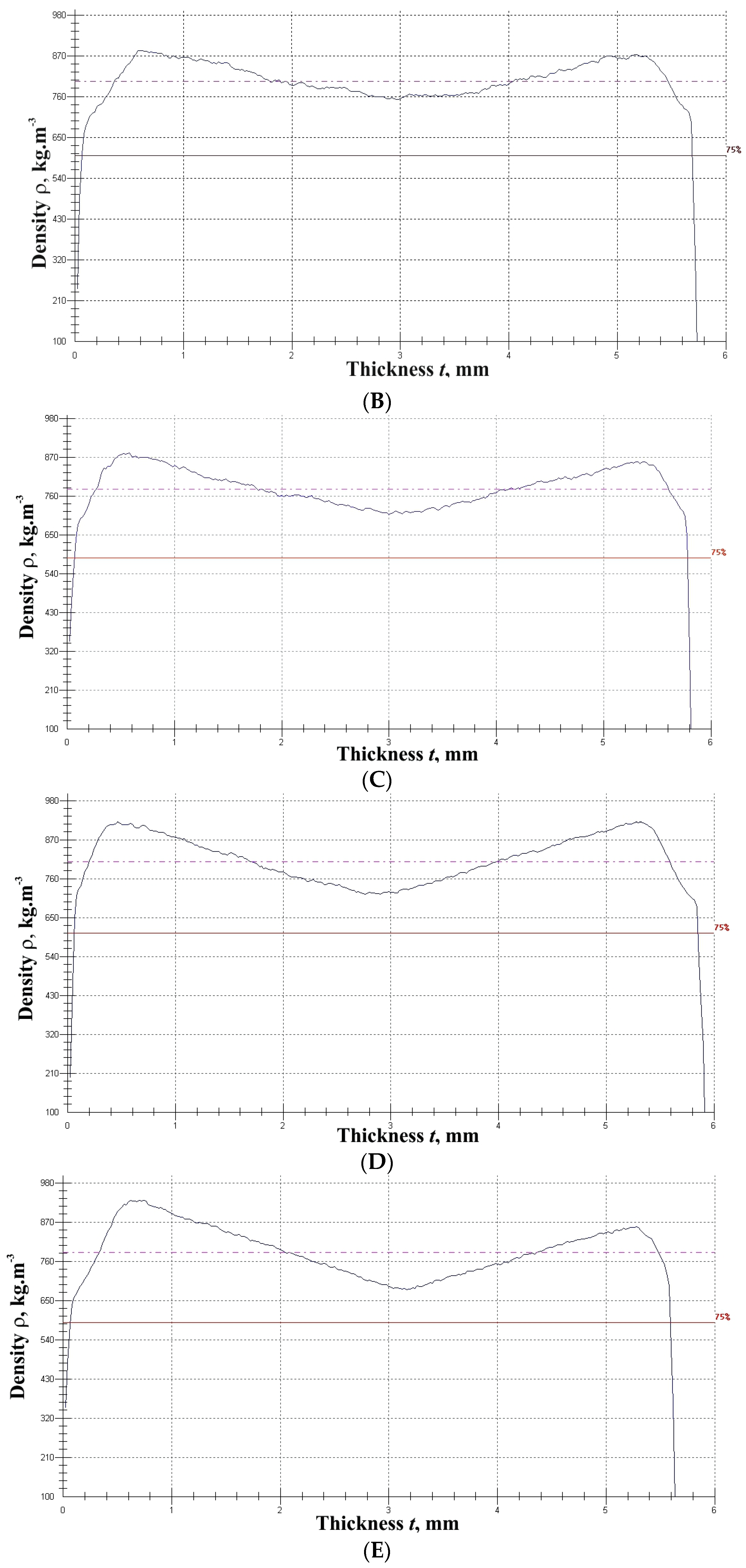


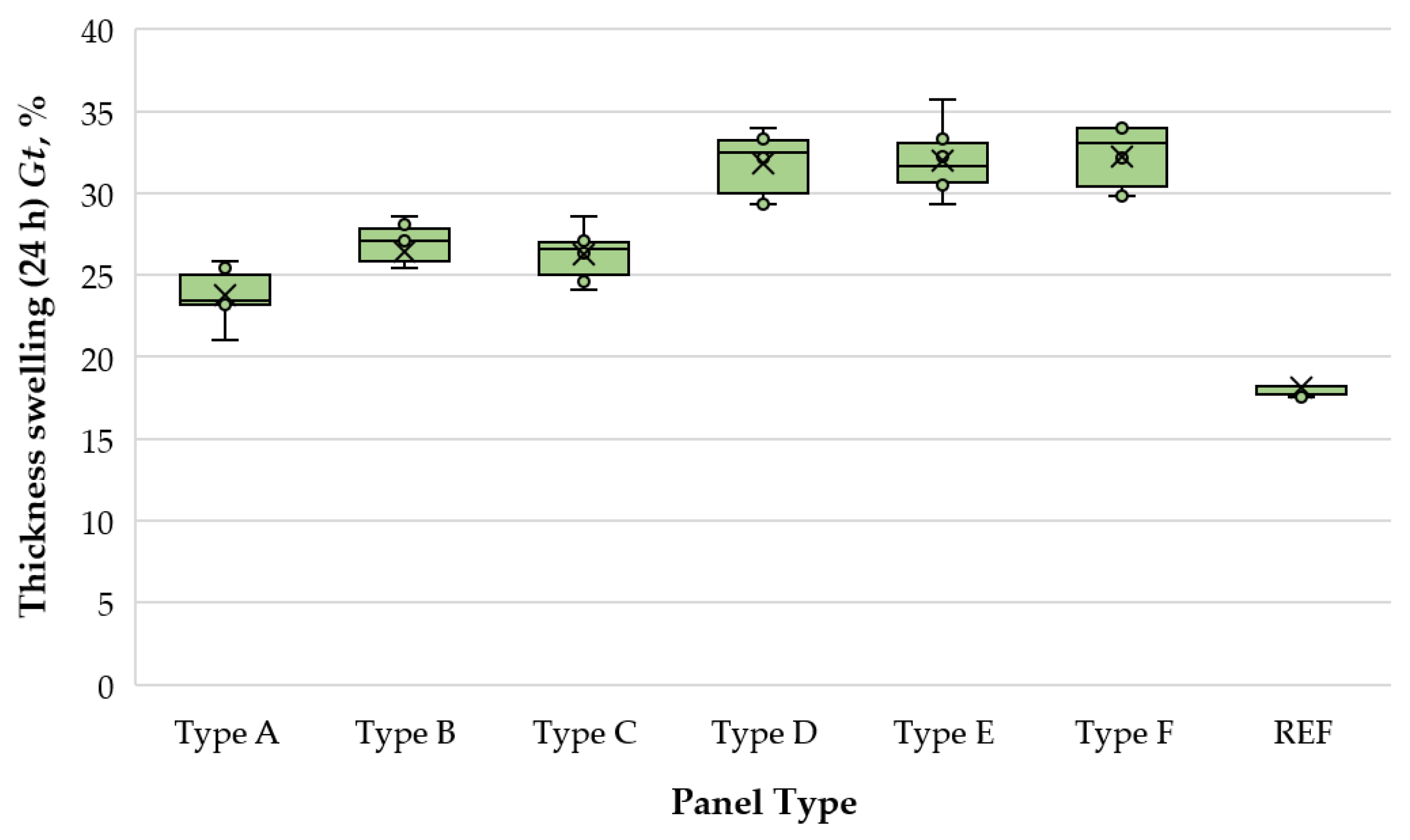
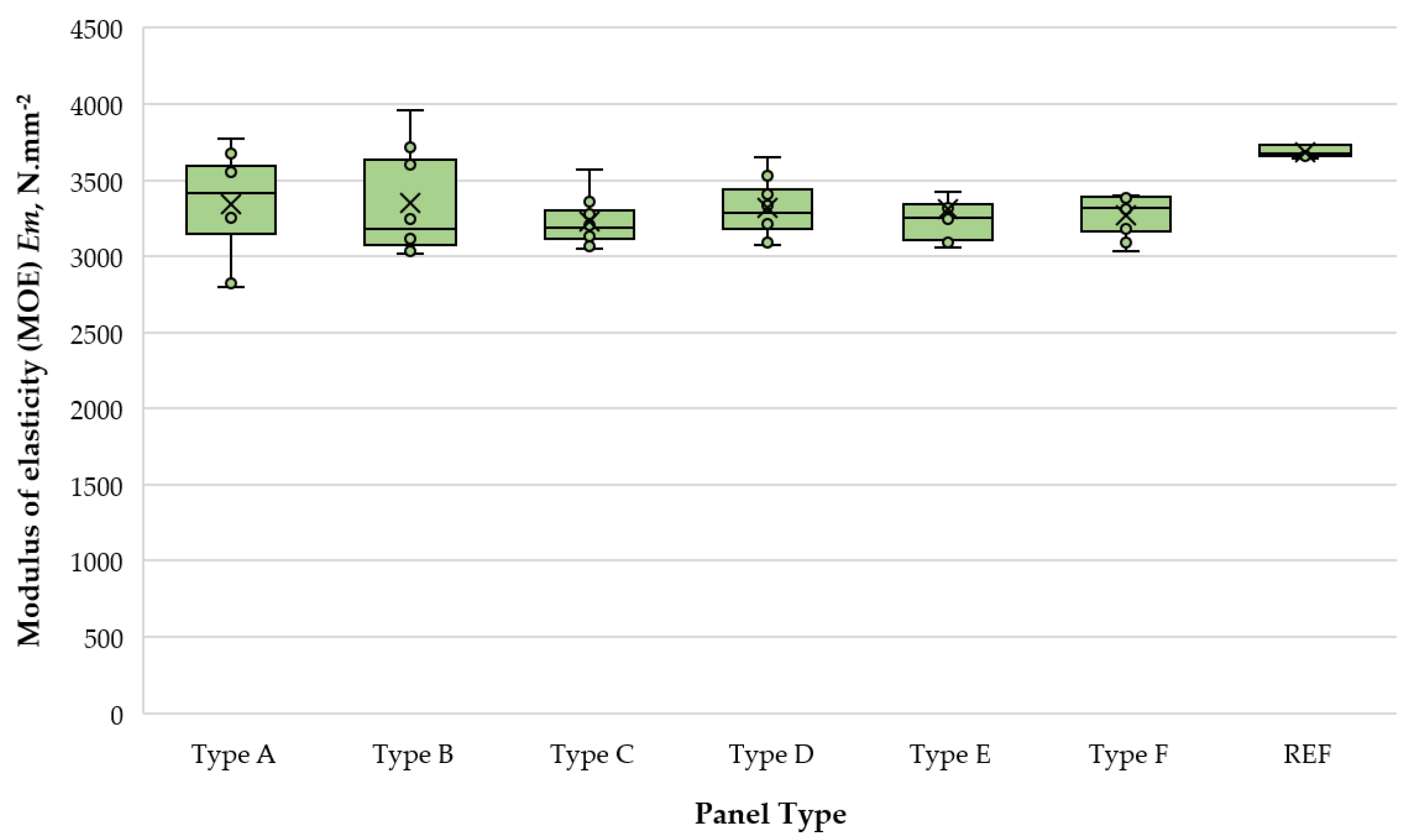
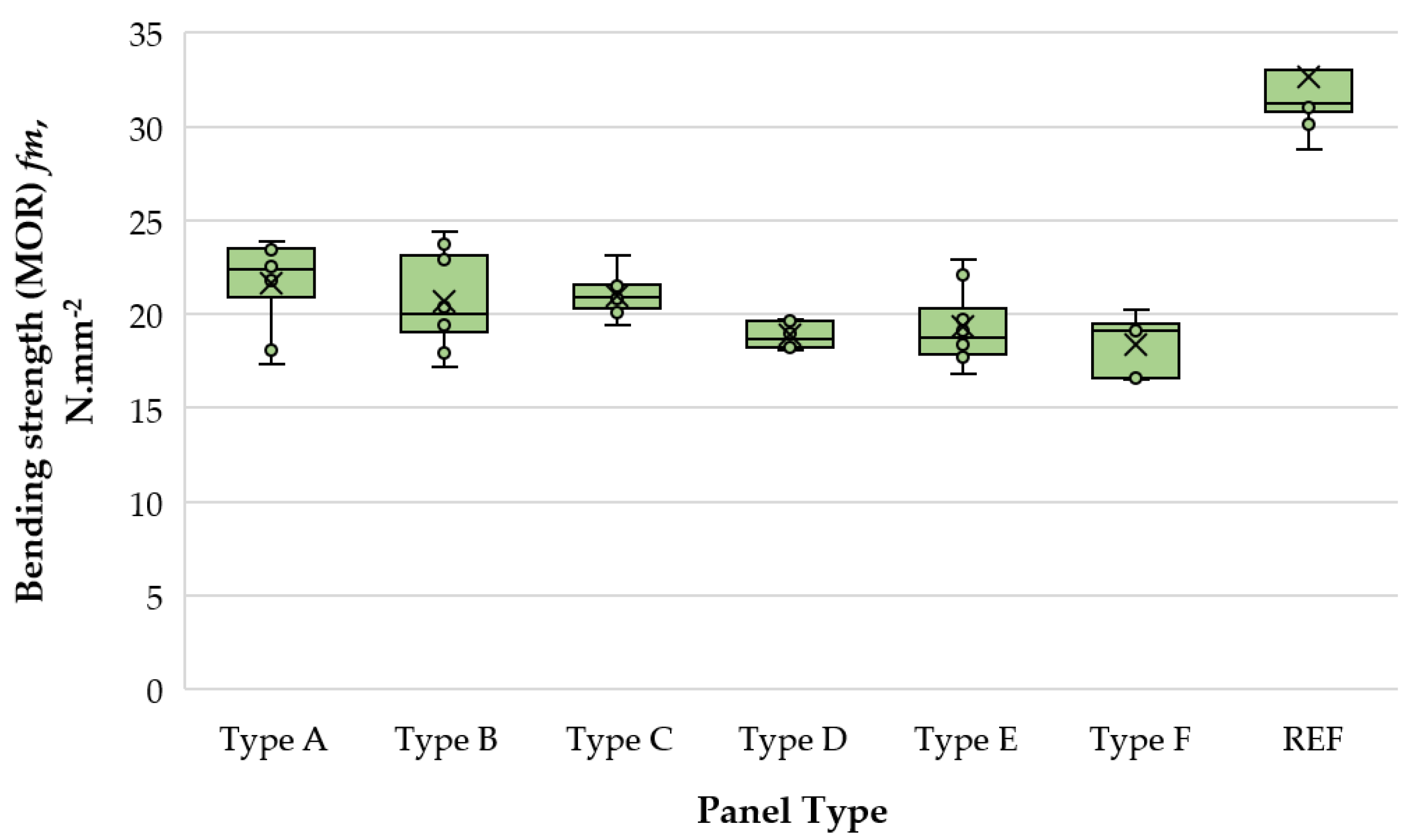
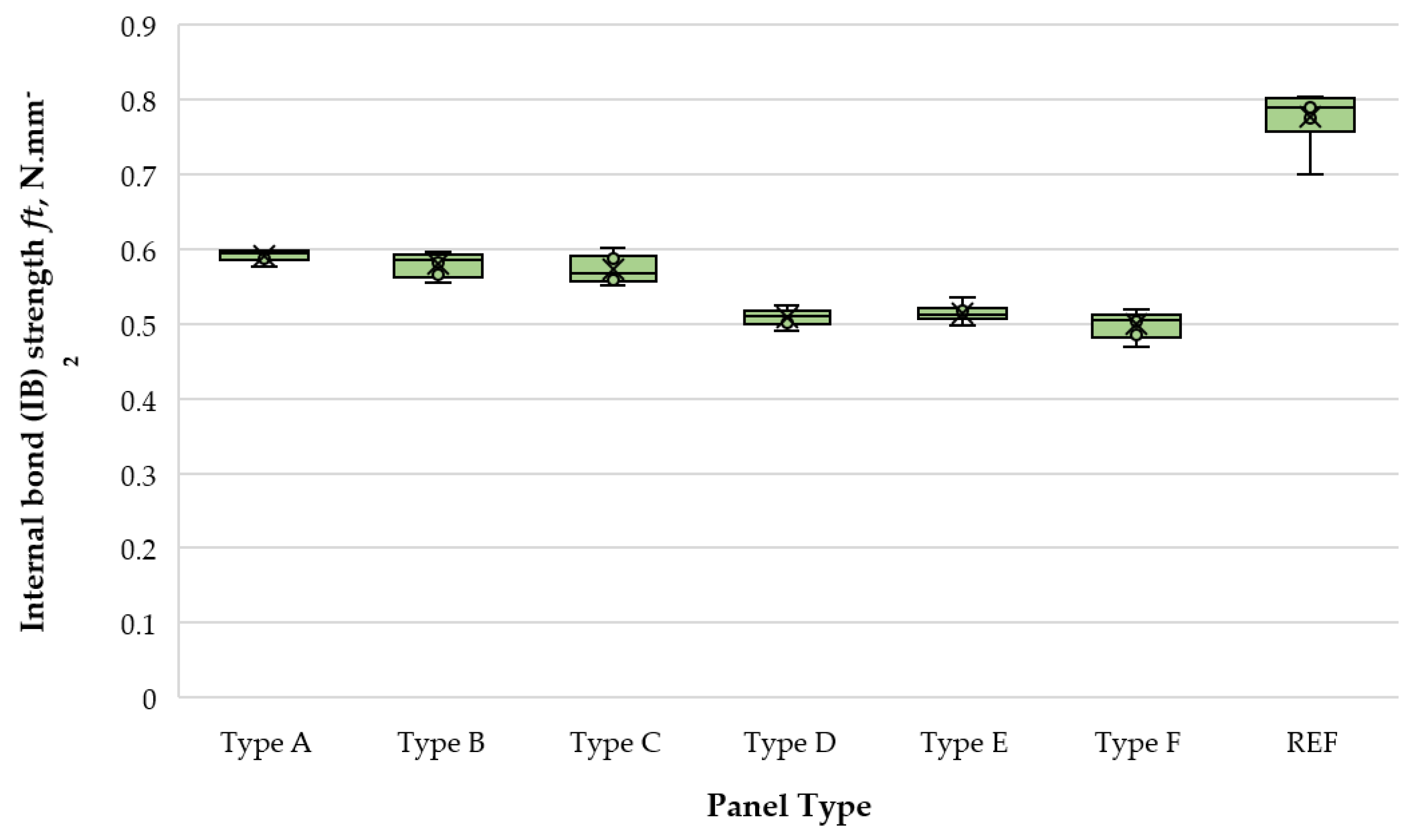




| Panel Type | Target Density | Hydrolysis Temperature T, °C | Hydrolysis Time τ, min |
|---|---|---|---|
| A | 780 | 121 | 30 |
| B | 780 | 121 | 45 |
| C | 780 | 121 | 60 |
| D | 780 | 134 | 30 |
| E | 780 | 134 | 45 |
| F | 780 | 134 | 60 |
| REF | 780 | 0 | 0 |
| Panel Type | Average (Mean Value) ρ, kg.m−3 | Standard Deviation Sy, kg.m−3 | Coefficient of Variation Vy, % | Standard Error my, kg.m−3 | Probability Py, % |
|---|---|---|---|---|---|
| Type A | 777 | 47.61 | 6.13 | 16.83 | 2.17 |
| Type B | 786 | 51.41 | 6.54 | 18.17 | 2.31 |
| Type C | 776 | 70.68 | 9.11 | 24.99 | 3.22 |
| Type D | 780 | 53.50 | 6.86 | 18.91 | 2.42 |
| Type E | 779 | 64.90 | 8.33 | 22.95 | 2.95 |
| Type F | 797 | 49.99 | 6.27 | 17.67 | 2.22 |
| REF | 783 | 28.32 | 3.62 | 10.01 | 1.28 |
| Source of Variation | SS | df | MS | F | p-Value | Fcrit |
|---|---|---|---|---|---|---|
| Panel type | 2630.581 | 6 | 438.4301 | 0.151336 | 0.987926 | 2.290432 |
| Error | 141,955.8 | 49 | 2897.057 | |||
| Total | 144,586.4 | 55 |
Disclaimer/Publisher’s Note: The statements, opinions and data contained in all publications are solely those of the individual author(s) and contributor(s) and not of MDPI and/or the editor(s). MDPI and/or the editor(s) disclaim responsibility for any injury to people or property resulting from any ideas, methods, instructions or products referred to in the content. |
© 2023 by the authors. Licensee MDPI, Basel, Switzerland. This article is an open access article distributed under the terms and conditions of the Creative Commons Attribution (CC BY) license (https://creativecommons.org/licenses/by/4.0/).
Share and Cite
Savov, V.; Antov, P.; Panchev, C.; Lubis, M.A.R.; Taghiyari, H.R.; Lee, S.H.; Krišťák, Ľ.; Todorova, M. The Impact of Hydrolysis Regime on the Physical and Mechanical Characteristics of Medium-Density Fiberboards Manufactured from Recycled Wood Fibers. Fibers 2023, 11, 103. https://doi.org/10.3390/fib11120103
Savov V, Antov P, Panchev C, Lubis MAR, Taghiyari HR, Lee SH, Krišťák Ľ, Todorova M. The Impact of Hydrolysis Regime on the Physical and Mechanical Characteristics of Medium-Density Fiberboards Manufactured from Recycled Wood Fibers. Fibers. 2023; 11(12):103. https://doi.org/10.3390/fib11120103
Chicago/Turabian StyleSavov, Viktor, Petar Antov, Christian Panchev, Muhammad Adly Rahandi Lubis, Hamid R. Taghiyari, Seng Hua Lee, Ľuboš Krišťák, and Martina Todorova. 2023. "The Impact of Hydrolysis Regime on the Physical and Mechanical Characteristics of Medium-Density Fiberboards Manufactured from Recycled Wood Fibers" Fibers 11, no. 12: 103. https://doi.org/10.3390/fib11120103
APA StyleSavov, V., Antov, P., Panchev, C., Lubis, M. A. R., Taghiyari, H. R., Lee, S. H., Krišťák, Ľ., & Todorova, M. (2023). The Impact of Hydrolysis Regime on the Physical and Mechanical Characteristics of Medium-Density Fiberboards Manufactured from Recycled Wood Fibers. Fibers, 11(12), 103. https://doi.org/10.3390/fib11120103











